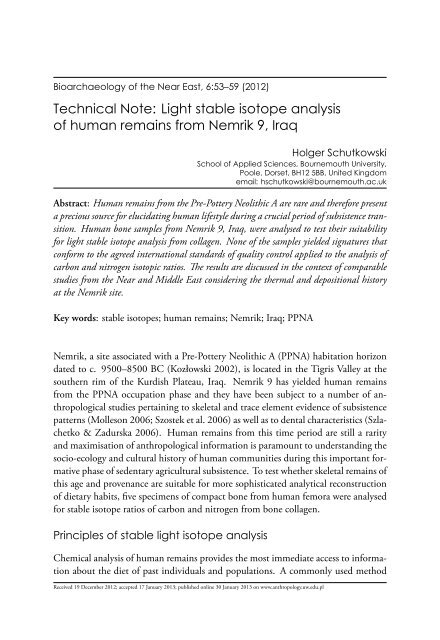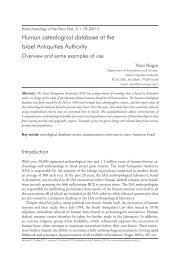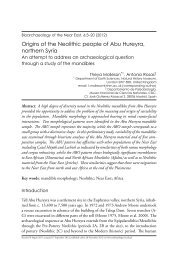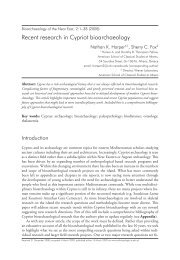Light stable isotope analysis of human remains from Nemrik 9, Iraq
Light stable isotope analysis of human remains from Nemrik 9, Iraq
Light stable isotope analysis of human remains from Nemrik 9, Iraq
You also want an ePaper? Increase the reach of your titles
YUMPU automatically turns print PDFs into web optimized ePapers that Google loves.
Bioarchaeology <strong>of</strong> the Near East, 6:53–59 (2012)<br />
Technical Note: <strong>Light</strong> <strong>stable</strong> <strong>isotope</strong> <strong>analysis</strong><br />
<strong>of</strong> <strong>human</strong> <strong>remains</strong> <strong>from</strong> <strong>Nemrik</strong> 9, <strong>Iraq</strong><br />
Holger Schutkowski<br />
School <strong>of</strong> Applied Sciences, Bournemouth University,<br />
Poole, Dorset, BH12 5BB, United Kingdom<br />
email: hschutkowski@bournemouth.ac.uk<br />
Abstract: Human <strong>remains</strong> <strong>from</strong> the Pre-Pottery Neolithic A are rare and therefore present<br />
a precious source for elucidating <strong>human</strong> lifestyle during a crucial period <strong>of</strong> subsistence transition.<br />
Human bone samples <strong>from</strong> <strong>Nemrik</strong> 9, <strong>Iraq</strong>, were analysed to test their suitability<br />
for light <strong>stable</strong> <strong>isotope</strong> <strong>analysis</strong> <strong>from</strong> collagen. None <strong>of</strong> the samples yielded signatures that<br />
conform to the agreed international standards <strong>of</strong> quality control applied to the <strong>analysis</strong> <strong>of</strong><br />
carbon and nitrogen isotopic ratios. e results are discussed in the context <strong>of</strong> comparable<br />
studies <strong>from</strong> the Near and Middle East considering the thermal and depositional history<br />
at the <strong>Nemrik</strong> site.<br />
Key words: <strong>stable</strong> <strong>isotope</strong>s; <strong>human</strong> <strong>remains</strong>; <strong>Nemrik</strong>; <strong>Iraq</strong>; PPNA<br />
<strong>Nemrik</strong>, a site associated with a Pre-Pottery Neolithic A (PPNA) habitation horizon<br />
dated to c. 9500–8500 BC (Kozłowski 2002), is located in the Tigris Valley at the<br />
southern rim <strong>of</strong> the Kurdish Plateau, <strong>Iraq</strong>. <strong>Nemrik</strong> 9 has yielded <strong>human</strong> <strong>remains</strong><br />
<strong>from</strong> the PPNA occupation phase and they have been subject to a number <strong>of</strong> anthropological<br />
studies pertaining to skeletal and trace element evidence <strong>of</strong> subsistence<br />
patterns (Molleson 2006; Szostek et al. 2006) as well as to dental characteristics (Szlachetko<br />
& Zadurska 2006). Human <strong>remains</strong> <strong>from</strong> this time period are still a rarity<br />
and maximisation <strong>of</strong> anthropological information is paramount to understanding the<br />
socio-ecology and cultural history <strong>of</strong> <strong>human</strong> communities during this important formative<br />
phase <strong>of</strong> sedentary agricultural subsistence. To test whether skeletal <strong>remains</strong> <strong>of</strong><br />
this age and provenance are suitable for more sophisticated analytical reconstruction<br />
<strong>of</strong> dietary habits, five specimens <strong>of</strong> compact bone <strong>from</strong> <strong>human</strong> femora were analysed<br />
for <strong>stable</strong> <strong>isotope</strong> ratios <strong>of</strong> carbon and nitrogen <strong>from</strong> bone collagen.<br />
Principles <strong>of</strong> <strong>stable</strong> light <strong>isotope</strong> <strong>analysis</strong><br />
Chemical <strong>analysis</strong> <strong>of</strong> <strong>human</strong> <strong>remains</strong> provides the most immediate access to information<br />
about the diet <strong>of</strong> past individuals and populations. A commonly used method<br />
Received 19 December 2012; accepted 17 January 2013; published online 30 January 2013 on www.anthropology.uw.edu.pl
54 Holger Schutkowski<br />
employs the <strong>analysis</strong> <strong>of</strong> <strong>stable</strong> light <strong>isotope</strong> ratios <strong>of</strong> carbon and nitrogen measured<br />
<strong>from</strong> bone collagen. Isotopes are species <strong>of</strong> the same chemical element. While their<br />
number <strong>of</strong> protons is identical, they differ in atomic weight due to varying numbers <strong>of</strong><br />
neutrons in their nucleus and the variants considered here are <strong>stable</strong>, i.e. not subject to<br />
radioactive decay. e standard notations δ¹³C or δ¹⁵N refer to the ratios <strong>of</strong> the heavier<br />
to the lighter <strong>stable</strong> <strong>isotope</strong>, ¹³C to ¹²C and ¹⁵N to ¹⁴N, respectively. Stable <strong>isotope</strong><br />
ratios <strong>from</strong> collagen lend themselves to palaeodietary <strong>analysis</strong> because they largely reflect<br />
protein intake <strong>from</strong> different foodstuffs (Ambrose 1993). Depending on trophic<br />
level, for example plant or animal protein, the isotopic ratio undergoes systematic<br />
alterations, a process known as fractionation (Schwarcz & Schoeninger 1991). e<br />
mass differences <strong>of</strong> <strong>isotope</strong>s, even though small and measured in parts per thousand<br />
(‘per mil’), influence the reaction kinetics during metabolic processes, which results<br />
in the step-wise discrimination against the slightly heavier <strong>isotope</strong>. erefore, during<br />
the passage <strong>from</strong> one trophic level to the other or, following the same principle, <strong>from</strong><br />
one tissue to the other, the end-product gets isotopically lighter, i.e. depleted in the<br />
heavier <strong>of</strong> the two <strong>isotope</strong>s. erefore, the value <strong>of</strong> an isotopic ratio indicates trophic<br />
position relative to other individuals and those organisms that supply the food web.<br />
Trophic level spacing for carbon typically amounts to 1-3‰, and for nitrogen 3-5‰.<br />
Carbon <strong>isotope</strong> ratios are measured against the internationally agreed baseline ratio <strong>of</strong><br />
bicarbonate in the PeeDee Belemnite formation (now the Vienna PeeDee Belemnite<br />
standard, vPDB), while nitrogen ratios vary against nitrogen in air (Ambient Inhalable<br />
Reservoir, AIR). Stable light <strong>isotope</strong> ratios measured <strong>from</strong> bone collagen reflect<br />
the regular and average diet <strong>of</strong> the last five to ten years before death (Tieszen & Fagre<br />
1993). In addition to fractionation, origin <strong>of</strong> foodstuffs and biochemical properties<br />
allow further differentiation <strong>of</strong> dietary intake.<br />
Plants generally follow two major different photosynthetic pathways, depending<br />
on whether carbon dioxide is incorporated into a three-carbon (Hatch-Slack cycle) or<br />
four-carbon compound (Calvin-Benson cycle) during absorption. Accordingly, there<br />
is more ¹³C carbon in C₄ plants, resulting in less negative values when compared<br />
against the reference standard. Isotope ratios therefore permit distinction between<br />
these groups <strong>of</strong> plants, which constitute the vast majority <strong>of</strong> vegetable matter <strong>human</strong>s<br />
use for cultivation and consumption. C₃ plants comprise cultivars <strong>from</strong> temperate<br />
climates, including common staples such as wheat, rye or barley and most vegetables,<br />
while C₄ plants originate <strong>from</strong> more arid and/or tropical zones, including maize, sugar<br />
cane, millet and sorghum, but also native grasses and chenopods. A smaller group <strong>of</strong><br />
plants, so-called C₃-C₄ intermediates, have developed the ability to switch between<br />
the C₃ and C₄ pathways in response to fluctuating environmental conditions, for<br />
example water stress or salinized soils (cf. Katzenberg 2008).
Isotopic <strong>analysis</strong> <strong>of</strong> <strong>human</strong> <strong>remains</strong> <strong>from</strong> <strong>Nemrik</strong> 55<br />
Carbon isotopic signatures thus allow the identification <strong>of</strong> relative amounts <strong>of</strong><br />
major plant groups contributing to the diet. Carbon derived <strong>from</strong> animal protein<br />
is isotopically different <strong>from</strong> that derived <strong>from</strong> plants <strong>of</strong> the same habitat and as a<br />
result, <strong>human</strong> δ¹³C values will be less negative when domestic or wild animals are<br />
contributing to the diet in measurable quantities. In the marine biotope, carbon isotopic<br />
ratios are generally more enriched and therefore enable the detection <strong>of</strong> seawater<br />
sources, especially when the terrestrial food components are C₃-based. e isotopic<br />
ratios <strong>of</strong> nitrogen in bone collagen best describe protein intake <strong>from</strong> animal sources<br />
due to their much higher protein content compared with plants, reflecting, for example,<br />
trophic level effects caused by meat consumption. As with carbon, fractionation<br />
occurs in both the terrestrial and marine biotope.<br />
Methods<br />
Sample preparation and measurement <strong>of</strong> <strong>stable</strong> <strong>isotope</strong> ratios<br />
Duplicate samples <strong>of</strong> c. 500mg weight were taken <strong>from</strong> cortical bone in <strong>human</strong> and<br />
terrestrial animal specimens, while vertebrae were sampled <strong>from</strong> fishes. Bone surfaces<br />
were cleaned using air abrasion with an aluminium oxide powder to remove adhering<br />
soil particles, and then subjected to a modified Longin method (Brown et al. 1988)<br />
for collagen extraction: samples are demineralised in 0.5M HCl at 2-5°C and then<br />
gelatinised at 72°C for 48h in deionised water adjusted to pH 3, with 0.5M HCl.<br />
is process typically took as long as 14 days, but occasionally, extraction times were<br />
extended depending on the actual size <strong>of</strong> the specimen. e extraction mix was filtered<br />
using Ezee filter separators (Elkay Laboratory Products, Basingstoke) to remove<br />
insoluble materials and then was purified again using Amicon Ultra-4 centrifugal filters<br />
(Millipore) to remove contaminants lower than 30,000 nominal molecular weight<br />
limit (Brown et al. 1988). e resulting solutions were lyophilised, a sub-sample <strong>of</strong><br />
0.4±0.1mg combusted and analysed by Isotope Ratio Mass Spectrometry (Finnigan<br />
Delta Plus XL).<br />
Quality control<br />
Methionine standard reference material, with known both δ¹³C (-26.6‰) and δ¹⁵N<br />
(-3.0‰) values (Elemental Micro<strong>analysis</strong>, Devon, UK) was measured at regular intervals<br />
in tandem with samples <strong>of</strong> bone collagen to examine the accuracy and precision<br />
<strong>of</strong> analytical methods, together with internal and external certified laboratory standards<br />
(e.g. IAEA standards, bovine liver, fish gel etc.; see Table 1). Collagen yield,<br />
the percentages <strong>of</strong> carbon and nitrogen, and the C:N ratio were recorded to control<br />
for possible effects <strong>of</strong> diagenetic processes (Ambrose 1993). As a sector standard<br />
in conjunction with the sample preparation method employed here, collagen yields
56 Holger Schutkowski<br />
as low as 0.5% were deemed acceptable (van Klinken 1999), however, usually only<br />
yields <strong>of</strong> 1% and higher are considered sufficient to indicate preservation <strong>of</strong> authentic<br />
collagen. For this study, samples that yielded between 0.5 and 1% collagen were considered<br />
suspect and any samples with collagen yields below 0.5% were discarded <strong>from</strong><br />
the <strong>analysis</strong> to take account <strong>of</strong> local sediment conditions that could have potentially<br />
impaired collagen preservation. Samples not having a C:N ratio between 2.9 and 3.6<br />
(the range known for native bone collagen) (Ambrose 1993) were omitted.<br />
Results and discussion<br />
Isotopic and quality control data are presented in Table 1. A comparison with internationally<br />
agreed protocols (see above) reveals that, whilst all standards to control<br />
for precision and accuracy <strong>of</strong> the measurements confirm fully satisfactory procedures,<br />
none <strong>of</strong> the <strong>human</strong> bone collagen samples met the quality control criteria to yield<br />
results, which can be used as meaningful indicators <strong>of</strong> dietary patterns. e weight<br />
percent figures for both carbon and nitrogen are below acceptable values and none<br />
<strong>of</strong> the C:N ratios fall within the range <strong>of</strong> figures known for native bone collagen. It<br />
has to be concluded, therefore, that the skeletal <strong>remains</strong>, at least those that were sampled,<br />
have undergone substantial degradation and loss <strong>of</strong> the organic component <strong>of</strong><br />
the bone tissue.<br />
Such a negative result, as disappointing as it may be, is not unusual (Weiner &<br />
Bar-Yosef 2004). Similar observations were made in comparable circumstances on the<br />
Arabian Peninsula (Grupe & Schutkowski 1989), where diagenetic alteration <strong>of</strong> the<br />
bone tissue occurred as the result <strong>of</strong> the specific depositional environment in desert<br />
arid soil, which led to quantitative loss <strong>of</strong> the organic portion. Analyses <strong>of</strong> bone samples<br />
<strong>from</strong> several arid sites in ancient Egypt also produced failure <strong>of</strong> sufficient and <strong>stable</strong><br />
collagen in a number <strong>of</strong> cases (ompson et al. 2005). e mechanism to suggest<br />
here is linked to high levels <strong>of</strong> evapo-transpiration in the microenvironment surrounding<br />
the burials. Substantial temperature differences between night and day cause oscillating<br />
capillary water transport in the soils and sediments and facilitate hydrolysis <strong>of</strong><br />
collagen and cleaving <strong>of</strong> the polypeptide chains (Piepenbrink & Schutkowski 1987),<br />
thus allowing for gradual leaching <strong>of</strong> fragmented proteins <strong>from</strong> the interred bones.<br />
Even though these examples reported on skeletal <strong>remains</strong> <strong>of</strong> much younger age (2ⁿd<br />
millennium BC) than those <strong>from</strong> <strong>Nemrik</strong>, a situation analogous to the concept <strong>of</strong><br />
thermal age (Smith et al. 2003), by which molecular and structural preservation <strong>of</strong> a<br />
specimen is governed by its thermal history rather than actual age, is likely to apply<br />
here. Conditions unfavourable to the preservation <strong>of</strong> complex biomolecules produce a<br />
higher rate <strong>of</strong> degradation than would be expected <strong>from</strong> the age <strong>of</strong> the sample alone. In<br />
the case <strong>of</strong> <strong>Nemrik</strong> it is the combination <strong>of</strong> historic age and specific burial conditions,
Isotopic <strong>analysis</strong> <strong>of</strong> <strong>human</strong> <strong>remains</strong> <strong>from</strong> <strong>Nemrik</strong> 57<br />
which result in deterioration at the molecular level despite satisfactory macroscopic<br />
preservation.<br />
In contrast, <strong>human</strong> <strong>remains</strong> recovered <strong>from</strong> more favourable depositional conditions<br />
in the Near and Middle East have produced valid and meaningful light <strong>stable</strong><br />
<strong>isotope</strong> results <strong>from</strong> bone collagen, as analyses <strong>of</strong> PPNA material <strong>from</strong> Nevalı Çori,<br />
Turkey (Lösch et al. 2006) or <strong>of</strong> Middle Bronze Age <strong>remains</strong> <strong>from</strong> Sidon, Lebanon<br />
Table 1. Human <strong>remains</strong> <strong>from</strong> <strong>Nemrik</strong> 9 – Results <strong>of</strong> light <strong>stable</strong> <strong>isotope</strong> <strong>analysis</strong>, including<br />
quality controls.<br />
Identifier Weight (mg) %N δ¹⁵N %C δ¹³C C/N Yield %<br />
<strong>Nemrik</strong><br />
NK2545a 1.15 0.3 5.23 2.9 -24.05 13.07 0.6<br />
NK2545b 1.02 0.2 7.10 2.5 -23.71 12.81<br />
NK2549a 1.07 0.1 12.88 1.4 -27.14 13.35 0.3<br />
NK2549b 0.60 0.2 -4.33 1.9 -27.41 13.11<br />
NK2549a¹ 1.65 0.2 7.80 1.2 -26.05 9.62 0.5<br />
NK2549b¹ 1.07 0.1 -3.81 1.4 -24.81 12.98<br />
NK3352a 1.07 0.1 -10.96 0.8 -22.79 8.99 0.9<br />
NK3352b 1.21 0.1 4.48 0.8 -17.51 14.30<br />
NK3357a 1.33 0.1 -20.08 0.3 -18.75 5.65 2.1<br />
NK3357b 1.29 0.0 6.77 0.3 -13.59 9.85<br />
NK3372a 1.18 0.1 23.53 0.6 -21.71 9.48 0.8<br />
NK3372b 1.34 0.1 16.77 0.7 -25.71 14.32<br />
Standards<br />
Bovine liver 1.25 10.1 7.64 48.6 -21.66 5.64 measured<br />
7.65±0.25 -21.59±0.25 certified<br />
Fish gel 1.00 22.0 14.13 56.9 -15.63 3.02 measured<br />
1.00 20.1 14.51 52.0 -15.50 3.02 measured<br />
1.47 16.9 14.51 43.2 -15.51 2.98 measured<br />
1.65 16.4 14.44 41.7 -15.37 2.98 measured<br />
1.34 16.1 14.47 41.2 -15.43 2.99 measured<br />
14.45 -15.52 certified<br />
IAEA600 0.33 28.3 1.05 49.4 -28.30 2.04 measured<br />
0.49 28.1 1.30 48.3 -27.72 2.00 measured<br />
1.03 27.6 1.08 46.8 -27.59 1.98 measured<br />
1.0±0.2 -27.77±0.04 certified<br />
N2 0.47 19.9 20.70 measured<br />
0.57 20.2 20.48 measured<br />
20.41±0.2 certified<br />
IAEA CH7 0.28 83.5 -32.11 measured<br />
-32.15±0.05 certified<br />
¹ Sample NK2549 was measured twice in duplicate to check for reproducibility.
58 Holger Schutkowski<br />
(Schutkowski & Ogden 2011) demonstrate. Analysis <strong>of</strong> other tissues, e.g. tooth<br />
enamel, <strong>from</strong> samples with a thermal history likely similar to that at <strong>Nemrik</strong> have<br />
been more successful (e.g. Gregoricka 2013, samples <strong>from</strong> the 3rd millennium BC)<br />
because <strong>of</strong> the virtual lack <strong>of</strong> organic matter and the densely packed mineral, resulting<br />
in much less diagenetic susceptibility <strong>of</strong> enamel in comparison with bone.<br />
Conclusion<br />
e general state <strong>of</strong> preservation <strong>of</strong> <strong>human</strong> skeletal <strong>remains</strong> <strong>of</strong> extended time depth<br />
and in latitudes characterised by unfavourable conditions <strong>of</strong> aridity and evapo-transpiration<br />
renders the survival <strong>of</strong> biomolecules unlikely. Under less harsh conditions<br />
the extraction <strong>of</strong> collagen and <strong>analysis</strong> <strong>of</strong> light <strong>stable</strong> <strong>isotope</strong>s <strong>from</strong> bone even <strong>of</strong> Pre-<br />
Pottery Neolithic date has been successful, but the relatively small corpus <strong>of</strong> such data<br />
<strong>from</strong> the Middle East testifies to the volatile nature <strong>of</strong> these endeavours, which are<br />
subject to the specific circumstances <strong>of</strong> the burial environment and the general climatic<br />
conditions. More targeted and tissue-specific analyses will have to be employed<br />
in future studies to unlock dietary and other lifestyle information <strong>from</strong> <strong>remains</strong> <strong>of</strong><br />
compromised depositional provenance.<br />
Acknowledgements<br />
I am grateful to Andrew Gledhill, Bradford <strong>Light</strong> Stable Isotope Facility, for preparation<br />
and measurement <strong>of</strong> the samples. Many thanks go to Arkadiusz Sołtysiak,<br />
Department <strong>of</strong> Bioarchaeology, Institute <strong>of</strong> Archaeology, University <strong>of</strong> Warsaw, for<br />
facilitating access to samples, which are curated in the State Archaeological Museum<br />
in Warsaw. e current research was financed by the Polish Ministry <strong>of</strong> Science and<br />
Higher Education, grant N N109 352236.<br />
References<br />
Ambrose S.H. (1993), Isotopic <strong>analysis</strong> <strong>of</strong> paleodiets: methodological and interpretive<br />
considerations [in:] “Investigations <strong>of</strong> ancient <strong>human</strong> tissues: Chemical analyses in<br />
anthropology”, K. Sandford (ed.), Langhorne: Gordon & Breach, pp. 1-37.<br />
Brown T.A., Nelson D.E., Southon J.R. (1988), Improved collagen extraction by a<br />
modified Longin method, Radiocarbon 30:171-177.<br />
Gregoricka L. (2013), Residential mobility and social identity in the periphery: Strontium<br />
<strong>isotope</strong> analyses <strong>of</strong> archaeological tooth enamel <strong>from</strong> southeastern Arabia, Journal<br />
<strong>of</strong> Archaeological Science 40:452-464.<br />
Grupe G., Schutkowski H. (1989), Dietary shift during the 2ⁿd millennium BC at<br />
prehistoric Shimal, Oman peninsula, Paléorient 15:77-84.
Isotopic <strong>analysis</strong> <strong>of</strong> <strong>human</strong> <strong>remains</strong> <strong>from</strong> <strong>Nemrik</strong> 59<br />
Katzenberg M.A. (2008), Stable <strong>isotope</strong> <strong>analysis</strong>: a tool for studying past diet, demography<br />
and life history [in:] “e biological anthropology <strong>of</strong> <strong>human</strong> skeletons”, 2ⁿd<br />
edition, M.A. Katzenberg, S.R. Saunders (eds.), New York: Wiley-Liss, pp. 413-<br />
441.<br />
Kozłowski, S.K. (2002), <strong>Nemrik</strong>: An aceramic village in northern <strong>Iraq</strong>, Warsaw: Institute<br />
<strong>of</strong> Archaeology, University <strong>of</strong> Warsaw.<br />
Lösch S., Grupe G., Peters J. (2006), Stable <strong>isotope</strong>s and dietary adaptations in <strong>human</strong>s<br />
and animals at pre-pottery Neolithic Nevalı Çori, southeast Anatolia, American<br />
Journal <strong>of</strong> Physical Anthropology 131:181-193.<br />
Molleson T. (2006), Hunters <strong>of</strong> <strong>Nemrik</strong>, Studies in Historical Anthropology 3:5-18.<br />
Piepenbrink H., Schutkowski H. (1987), Decomposition <strong>of</strong> skeletal <strong>remains</strong> in desert<br />
dry soil. A roentgenological study, Human Evolution 2:481-491.<br />
Schutkowski H., Ogden A.R. (2011), Sidon <strong>of</strong> the Plain, Sidon <strong>of</strong> the Sea – Reflections<br />
on Middle Bronze Age diet in the Eastern Mediterranean, Archaeology and History<br />
in the Lebanon 34/35:213-225.<br />
Schwarcz H.P., Schoeninger M.J. (1991), Stable <strong>isotope</strong> <strong>analysis</strong> in <strong>human</strong> nutritional<br />
ecology, Yearbook <strong>of</strong> Physical Anthropology 43:283-321.<br />
Smith C.I., Chamberlain A.T., Riley M.S., Stringer C., Collins M.J. (2003), e<br />
thermal history <strong>of</strong> <strong>human</strong> fossils and the likelihood <strong>of</strong> successful DNA amplification,<br />
Journal <strong>of</strong> Human Evolution 45:203-217.<br />
Szlachetko K., Zadurska M. (2006), Human teeth <strong>from</strong> <strong>Nemrik</strong>, Studies in Historical<br />
Anthropology 3:31-91.<br />
Szostek K., Głąb H., Kaczanowski K. (2006), An <strong>analysis</strong> <strong>of</strong> the content <strong>of</strong> macroand<br />
microelements in the teeth <strong>of</strong> an Early Neolithic population <strong>from</strong> <strong>Nemrik</strong> (<strong>Iraq</strong>),<br />
Studies in Historical Anthropology 3:19-29.<br />
ompson A.H., Richards M.P., Shortland A., Zakrzewski S.R. (2005), Isotopic palaeodiet<br />
studies <strong>of</strong> ancient Egyptian fauna and <strong>human</strong>s, Journal <strong>of</strong> Archaeological Science<br />
32:451-463.<br />
Tieszen L., Fagre T. (1993), Effect <strong>of</strong> diet quality and composition on the isotopic composition<br />
<strong>of</strong> respiratory CO₂, bone collagen, bioapatite and s<strong>of</strong>t tissues [in:] “Prehistoric<br />
<strong>human</strong> bone. Archaeology at the molecular level”, J. Lambert, G. Grupe (eds.),<br />
Berlin: Springer, pp. 121-155.<br />
Weiner S., Bar-Yosef O. (2004), States <strong>of</strong> preservation <strong>of</strong> bones <strong>from</strong> prehistoric sites in<br />
the Near East: A survey, Journal <strong>of</strong> Archaeological Science 17:187-196.<br />
van Klinken G.J. (1999), Bone collagen quality indicators for palaeodietary and radiocarbon<br />
measurement, Journal <strong>of</strong> Archaeological Science 26:687-695.






